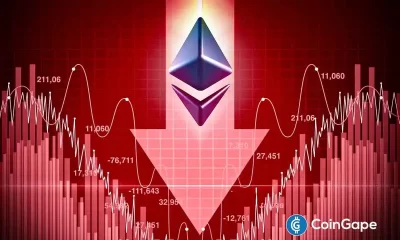AI
Blockchain has the answer to AI avatar risks
Published
5 days agoon
By
admin
Disclosure: The views and opinions expressed here belong solely to the author and do not represent the views and opinions of crypto.news’ editorial.
AI-generated avatars and virtual assistants will revolutionize our digital landscape, powering virtual influencers, workplace stand-ins, and immersive metaverse experiences. Yet, beneath this technological marvel lies a pressing question: who truly owns and controls your digital identity? The reality is stark—most AI avatars are tethered to centralized platforms where corporations hold dominion, exposing users to exploitation, financial fraud, and a profound loss of autonomy. As these digital personas become integral to our virtual lives, the need for a transformative solution has never been more urgent.
Decentralizing AI avatars through blockchain technology and smart contracts emerges as a vital antidote, promising to restore control to individuals in an increasingly virtualized world. The dangers of centralized systems are vividly demonstrated by high-profile abuses that have shaken public trust. In January 2024, a deepfake robocall mimicking U.S. President Joe Biden targeted New Hampshire voters, falsely urging Democrats to skip the primary in a bid to sway the 2024 election. This brazen act of manipulation, which prompted an FCC ruling to ban deepfake robocalls and ignited debates over AI regulation, exposed the fragility of centralized platforms that harbor the data fueling such scams.
The entertainment industry offers another stark warning. In early 2024, explicit deepfake images of Taylor Swift flooded social media, amassing over 45 million views before removal after a 17-hour delay. This incident laid bare the limitations of centralized content moderation, which often falters under pressure, leaving women and public figures disproportionately vulnerable to digital harm. The fallout was swift—Swift’s team condemned the breach, and platforms scrambled to respond, yet the delay highlighted a systemic failure to protect digital likenesses in real-time.
Additionally, Meta’s Oversight Board recently took up cases involving deepfake explicit imageries, noting inconsistent moderation practices— certain content was removed faster than others due to not passing specific community guidelines, highlighting inequities in centralized systems. These examples show how centralized avatar management leaves users powerless and unable to prevent misuse of their digital likeness.
Why AI avatars need to be decentralized
Centralized platforms trap users in ecosystems where their digital identities are subject to exploitation or sudden deactivation at corporate whim. This unchecked dominance shatters the vision of a user-empowered digital future, reducing individuals to mere cogs in a profit-driven machine. Decentralization flips this narrative, fostering self-sovereign identity where users hold the reins, owning and managing their avatars with confidence.
By placing control in the hands of individuals, decentralized systems can curb corporate overreach, ensuring AI avatars reflect their creators’ intent rather than serve as tools for exploitation.
Blockchain-powered AI ownership
Blockchain technology stands as a beacon of hope against these escalating threats. Through on-chain verification, it forges an unalterable record of avatar ownership, forging a secure bond between digital identities and their rightful owners while decisively countering unauthorized deepfake abuse.
This was painfully evident in February 2023, when a French interior designer fell pray in a romance scam: fraudsters wielded AI-generated images and messages to impersonate Brad Pitt, spinning a tale of a fabricated relationship and a fabricated cancer diagnosis that convinced her to part with €830,000—her life savings—before the deception unraveled. Such episodes unveil the dangers of centralized platforms, which hoard user data and become fertile ground for AI-driven fraud, eroding trust and inflicting devastating personal losses. Without a verifiable system to authenticate digital identities, AI-driven deception will only intensify. Users are left defenseless as deepfakes become more sophisticated and harder to detect. The challenge is clear: How can we secure digital avatars against misuse while ensuring individuals, not corporations, maintain control over their online presence?
Yet, blockchain’s potential extends further. Smart contracts bolster this framework by automating rights management, guaranteeing avatars operate with unwavering security and transparency while fortifying defenses against fraud. This comprehensive approach not only shields digital assets from theft but also alleviates the ethical and legal burdens intensified by centralized oversight, equipping users with verifiable dominion over their virtual selves.
A web3 future for AI avatars
Decentralized AI avatars can also drive a vibrant web3 economy, integrating into metaverses, digital workspaces, and decentralized social networks. These avatars can become dynamic assets—representing users in virtual worlds, facilitating remote collaboration, or enabling secure interactions online. Picture a musician selling a unique avatar on a decentralized marketplace or a professional using a blockchain-verified digital twin to authenticate their presence in a virtual meeting. This ecosystem thrives on user ownership, positioning decentralized AI avatars as a foundation for the next digital economy.
The drive to decentralize AI avatars is non-negotiable—centralized systems, exposed by explosive deepfake scandals and crumbling moderation, threaten to dismantle safety and freedom in an AI-drenched world. Blockchain carves a decisive path to empowerment, handing the reins of digital identity back to individuals, not corporate overlords. The clock is ticking: seize control of your digital destiny now, or watch it vanish into a dystopian abyss of corporate domination.

Roman Cyganov
Roman Cyganov is the founder and CEO of Antix, a company at the forefront of web3, AI, and gaming technologies. Recognized by OUTPUT as one of the Top 10 Global Talents, Roman has a rich history of driving technological innovation and redefining how businesses engage with digital audiences. Under his leadership, Antix has developed AIGE, a cutting-edge technology that crafts hyper-realistic AI-powered digital humans, revolutionizing client interactions in the digital space. Roman’s entrepreneurial journey includes co-founding VIVIX Inc., where he served as CCO before his pivotal role at Antix. His career is marked by a successful exit and numerous high-profile ventures that underscore his role as a serial entrepreneur leading the next wave of digital transformation.
Source link
You may like


Dogecoin Follows This Blueprint, Says Crypto Analyst


Metaplanet Buys Additional ¥3.8 Billion Worth Of Bitcoin


Crypto Trader Unveils Massive Bitcoin Price Target Amid Extended BTC Bull Market – Here’s His Outlook


Is it possible to make $1m with crypto?


Japan’s Metaplanet Buys Another $26M in Bitcoin Amid Tariff Market Uncertainty


Has Ethereum Price Bottomed? 3 Reason Why ETH Could Crash More


Disclosure: The views and opinions expressed here belong solely to the author and do not represent the views and opinions of crypto.news’ editorial.
Chinese companies are leading the AI arms race. Chinese politician and computer scientist Lou Qinjian said as much, recently commending DeepSeek for their accomplishments: “DeepSeek adheres to an open-source approach and promotes the widespread application of AI technology globally, which contributes Chinese wisdom to the world,” he said.
“Through the rise of companies like DeepSeek, we can see the innovation and inclusiveness of China’s technological development.”
In February, at the Artificial Intelligence Action Summit in Paris, US Vice President JD Vance made clear where the Trump Administration stands on artificial intelligence. He said that, first and foremost, the Trump administration will ensure that American AI technology remains “the gold standard” worldwide and that US companies remain the partner of choice for international companies and foreign countries.
The Vice President argued that excessive regulation in the AI sector would kill the nascent industry, and that the administration would encourage pro-AI growth policies. “And I’d like to see that deregulatory flavor, making its way into a lot of the conversations at this conference,” he said. Vance also made it clear that AI should be free of ideological bias and that “American AI will not be co-opted into a tool for authoritarian censorship.”
Finally, the Trump administration will safeguard a pro-worker growth path for AI so it can create jobs in the United States. Vance also brought up the notion of foreign adversaries weaponizing AI software to rewrite history, surveil users, and censorship. As Vance stated:
“This is hardly new, of course, as they do with other tech. Some authoritarian regimes have stolen and used AI to strengthen their military intelligence and surveillance capabilities, capture personal data, and create propaganda to undermine other nations’ national security.”
He warned conference attendees against partnering with such regimes. “From CCTV to 5G equipment, we’re all familiar with cheap tech in the marketplace that’s been heavily subsidized and exported by authoritarian regimes,” he said. “But as I know, and I think some of us in this room have learned from experience, partnering with them means chaining your nation to an authoritarian master that seeks to infiltrate, dig in, and seize your information infrastructure.”
Under the hood of DeepSeek
DeepSeek shocked global markets in January with low-cost models that made it seem like US companies were now behind in the AI arms race. The AI lowered the costs of developing reliable AIs, proving itself to be a powerful and cost-efficient open-source language model.
It changed the way we view how much capital and computational resources are needed to develop AI. Researchers across the Western world are now left playing catch-up, studying DeepSeek’s technical advances and social implications.
There are clear benefits to DeepSeek. For instance, startups without the deep pockets of Google and OpenAI can now compete in the AI sector. AI models can do more with less in the post-DeekSeep world. The company claims it took a mere $6 million using 2,000 Nvidia H800 graphics processing units (GPUs) versus the $80 million to $100 million cost of GPT-4 and the 16,000 H100 GPUs needed for Meta’s LLaMA 3.
The Hangzhou-based startup’s AI model employs reasoning capabilities that allow smaller models, whereas other AIs have had to employ larger models. It also uses reinforcement learning, eliminating the need for supervised fine-tuning. Moreover, DeepSeek’s multi-head latent attention (MHLA) mechanism decreases memory usage to 5%, down from 13%, in earlier AI methods.
DeepSeek raises privacy concerns and questions regarding data-sourcing and copyright. DeepSeek is open-weighted, not open source. Open source models share the full source code and data, and open weight models share trained weights but not the code. Therefore, the exact source code used to train the models is not available.
Due to DeepSeek’s open weight model, it is unknown what its sources are. This seems to be the way most AI companies operate. DeepSeek made public its R1 training and open weight models, which will allow other AI developers to copy and build on the model, but not its sources.
DeepSeek and geopolitics
A race for AI dominance between China and the US has come into focus, while Russian capabilities on the matter remain a secret. Sberbank—Russia’s largest state-owned bank—has revealed its intentions to collaborate with Chinese researchers on AI projects. Russia and China, which share what they call a “no limits” strategic partnership, have long talked about AI cooperation—including in military applications—but little is publicly known about its depth or scope.
Sberbank, under CEO German Gref, once a Soviet-style former state savings bank burdened by onerous bureaucracy, is today one of Russia’s leading players in artificial intelligence. It released its GigaChat model in 2023. “Sberbank has many scientists. Through them, we plan to conduct joint research projects with researchers from China,” Sberbank First Deputy CEO Alexander Vedyakhin told Reuters.
As the AI arms race heats up, the benefits of open source innovation come to the forefront. Little flowers bursting through the concrete all around the world, coming up with cool tech that is open-sourced and decentralized.
Manouk Termaaten
Manouk Termaaten is the founder and CEO of Vertical Studio AI.
Source link


Several startups at the intersection of AI, blockchain, and fintech announced funding rounds this week. Codex raised the most capital, filling its coffers with $15.8 million.
Dragonfly Capital led the seed round. According to Fortune, which first broke the news, the effort was part of a seed round with roughly $14 million coming from Dragonfly.
Coinbase and Circle also took part in the fundraising, alongside Cumberland, Wintermute and Selini Capital.
That was just one of several funding rounds announced in the past week. Read on for more.
Ultra
- Luxembourg-based multi-family office NOIA Capital led the round through its NOIA Digital Assets fund.
- This latest investment follows the appointment of Gus van Rijckevorsel as our the company’s new CEO
The9 Limited
- The9 secured a $8 million investment through private placement agreements with leading cryptocurrency investment funds Elune Capital, Fine Vision Fund, and Bripheno Pte. Ltd.
- The company will issue Class A common shares priced based on the average closing price over the past 30 trading days. The newly issued shares are subject to a statutory lock-up period.
Ambient
- Ambient, a project merging AI and blockchain to deliver fast, low-cost smart services, has raised $7.2 million in a seed funding round backed by a16z’s crypto accelerator and Delphi Digital.
- The project uses a Bitcoin-like proof-of-work mechanism for security and a Solana-style architecture for speed and scalability, positioning it as a promising player in AI-driven blockchain innovation.
Cambrian Network
- Cambrian Network, a decentralized AI finance protocol, has raised $5.9 million in a seed funding round led by a16z’s Crypto Startup Accelerator (CSX), with participation from Blockchain Builders and The Graph ecosystem angels.
- The funding supports Cambrian’s upcoming testnet and its involvement in the CSX 04 accelerator in San Francisco. Cambrian provides agents with real-time and historical financial data by integrating on-chain and off-chain sources, including social sentiment, to enhance decision-making. Its protocol lets developers balance speed and security by choosing between optimistic and verifiable data.
Mahojin
- Mahojin, an AI and blockchain integration project, has raised $5 million in a Series A funding round led by a16z Crypto’s CSX and Maelstrom Fund. The funding will support the development of open-source tools aimed at improving interoperability between AI and decentralized technologies.
- The company focuses on building AI-powered decentralized applications and is positioning itself as a key player at the intersection of open-source innovation and blockchain infrastructure.
Momentum
- Momentum, an early-stage startup aiming to automate collaboration between sales teams and the broader organization, has raised a $5 million seed round.
- The funding was led by Basis Set Ventures, with participation from Inovia Capital, Leadout Capital, South Park Commons, and industry angel investors.
Notable crypto VC funding rounds < $5 million
- The Fragmetric token sale went live on the Legion platform. It will run until April 8. The sale has a hard cap of $4 million, with a fully diluted valuation of $125 million.
- In a seed funding round, luxury investment platform Collecto raised €2.8 million (approximately $3.05 million). LinkedIn Italy CEO Marcello Albergoni, Accenture Interactive Managing Director Alessandro Zanotti, and senior partners from McKinsey Andrea Travasoni and Guido Frisiani led the investment.
- The hyper-casual finance platform Hana Network raised $1.75 million in a public sale round at a $40-million fully diluted valuation.
- Bloctopus, formerly known as LZero, raised $1 million in a seed round.
- StakeStone raised $1 million to strengthen its one-stop staking protocol for omnichain LST liquidity.
- BAI Fund, an on-chain agent fund operating within a Trusted Execution Environment (TEE), raised $1 million. Morph and Foresight Ventures participated in the effort.
Source link
AI
Bittensor spikes 20% after Coinbase announces TAO listing
Published
2 months agoon
February 19, 2025By
admin

Bittensor price rose sharply on Feb. 19 after crypto exchange Coinbase announced the listing of the native token of the decentralized artificial intelligence network.
As most altcoins registered notable gains in the past 24 hour period, Bittensor (TAO) spiked 20% to hit intraday highs of $420. These gains were modest compared to outperformers in the top 100 coins by market cap such as Story, Sonic, Aptos and Floki. However, with double digit gains, Bittensor ranked among the top performers.
The performance saw TAO recoup losses it suffered in the past few days as alts mirrored Bitcoin’s struggles. With 20% upside, bulls wiped most of the accrued losses in the month-to-date period, returning to levels seen when Bittensor price reacted positively to AI news around DeepSeek.
Coinbase to list TAO
A dose of volatility saw Bitcoin rebound above $96,000 and XRP rise 6% amid news of Hashdex’s spot XRP exchange-traded fund approval in Brazil. Cryptocurrencies traded slightly higher as investors awaited the Federal Open Market Committee meeting minutes.
This, along with Coinbase’s upcoming listing of Bittensor on Feb. 20, helped push TAO higher.
In an announcement, the U.S.-based crypto exchange confirmed it would add trading support for TAO on the Bittensor network. The phased launch will offer trading with the TAO/USD pair.
“Trading will begin on or after 9AM PT on February 20 2025 if liquidity conditions are met. Once sufficient supply of this asset is established trading on our TAO-USD trading pair will launch in phases,” Coinbase wrote on X.
Bittensor’s price also soared earlier this month after the project released its Dynamic TAO whitepaper, outlining a major upgrade.
Does TAO listing on Coinbase matter?
Bittensor is a top AI token by market cap, currently the second-largest behind NEAR. Notably, the native token is already listed on Binance, Kraken and other top exchanges. Coinbase listing is nonetheless key as it could give Bittensor further traction.
Besides, the project that launched in 2019 has received investment backing from some of the top venture capital players in the market, including Pantera Capital, Digital Currency Group and Lyrik Ventures.
Grayscale recently noted Bittensor is a crucial project in the AI space as its decentralized model can help increase transparency and democratize access.
According to Grayscale, this is key in the wake of projects such as DeepSeek. While these initiatives highlight the power and potential of open-source AI, the fact that they are centralized companies means there could be risks such as data security and embedded biases. A lack of transparency is another major concern.
Source link

Dogecoin Follows This Blueprint, Says Crypto Analyst

Metaplanet Buys Additional ¥3.8 Billion Worth Of Bitcoin

Crypto Trader Unveils Massive Bitcoin Price Target Amid Extended BTC Bull Market – Here’s His Outlook

Is it possible to make $1m with crypto?

Japan’s Metaplanet Buys Another $26M in Bitcoin Amid Tariff Market Uncertainty

Has Ethereum Price Bottomed? 3 Reason Why ETH Could Crash More
Michael Saylor Teases New Bitcoin Buy After Strategy’s $7.69 Billion Q1 BTC Buying Spree

Crypto markets ‘relatively orderly’ despite Trump tariff chaos: NYDIG

Fartcoin ‘Hot Air Rises’ — $1.50 Just A Whiff Away

What happened to the RWA token?

Crypto Strategist Sees Solana-Based Memecoin Surging Higher, Says One AI Altcoin Flashing Strong Chart

Mantra Team Responds As The OM Token Price Crashes Over 80% In 24 Hours

This Week in Crypto Games: Gaming Tokens Crash Out, Eve Frontier Opens Up

Commerce Secretary Lutnick walks back tariff relief on electronics

Gold ETF Inflows Hit Three-Year High as PAXG, XAUT Outperform Wider Crypto Market

Arthur Hayes, Murad’s Prediction For Meme Coins, AI & DeFi Coins For 2025

Expert Sees Bitcoin Dipping To $50K While Bullish Signs Persist

Aptos Leverages Chainlink To Enhance Scalability and Data Access

Bitcoin Could Rally to $80,000 on the Eve of US Elections

Crypto’s Big Trump Gamble Is Risky

Institutional Investors Go All In on Crypto as 57% Plan to Boost Allocations as Bull Run Heats Up, Sygnum Survey Reveals

Sonic Now ‘Golden Standard’ of Layer-2s After Scaling Transactions to 16,000+ per Second, Says Andre Cronje

Ripple-SEC Case Ends, But These 3 Rivals Could Jump 500x

Has The Bitcoin Price Already Peaked?

A16z-backed Espresso announces mainnet launch of core product

The Future of Bitcoin: Scaling, Institutional Adoption, and Strategic Reserves with Rich Rines

3 Voting Polls Show Why Ripple’s XRP Price Could Hit $10 Soon

Xmas Altcoin Rally Insights by BNM Agent I

Blockchain groups challenge new broker reporting rule

I’m Grateful for Trump’s Embrace of Bitcoin
Trending

 24/7 Cryptocurrency News5 months ago
24/7 Cryptocurrency News5 months agoArthur Hayes, Murad’s Prediction For Meme Coins, AI & DeFi Coins For 2025

 Bitcoin3 months ago
Bitcoin3 months agoExpert Sees Bitcoin Dipping To $50K While Bullish Signs Persist

 24/7 Cryptocurrency News3 months ago
24/7 Cryptocurrency News3 months agoAptos Leverages Chainlink To Enhance Scalability and Data Access

 Bitcoin5 months ago
Bitcoin5 months agoBitcoin Could Rally to $80,000 on the Eve of US Elections

 Opinion5 months ago
Opinion5 months agoCrypto’s Big Trump Gamble Is Risky

 Bitcoin5 months ago
Bitcoin5 months agoInstitutional Investors Go All In on Crypto as 57% Plan to Boost Allocations as Bull Run Heats Up, Sygnum Survey Reveals

 Altcoins2 months ago
Altcoins2 months agoSonic Now ‘Golden Standard’ of Layer-2s After Scaling Transactions to 16,000+ per Second, Says Andre Cronje

 Price analysis5 months ago
Price analysis5 months agoRipple-SEC Case Ends, But These 3 Rivals Could Jump 500x


